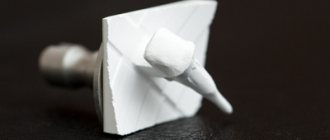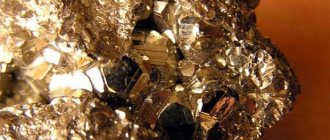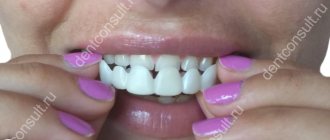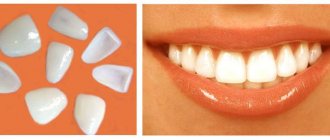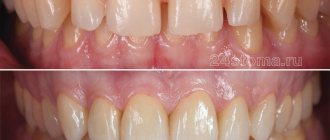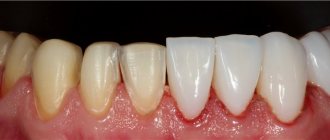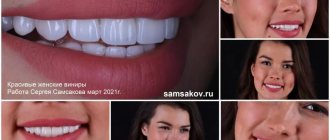Porcelain veneers
Porcelain plates are visually indistinguishable from the enamel of a normal tooth. Therefore, ordinary people will never guess about the installed records.
The advantages of ceramic crowns are that they are resistant to stress and practically do not stain.
Porcelain microprostheses are made using two methods:
1. Pressed ceramics - the material is applied in layers, then each layer is fired. In this case, the teeth are not ground down.
2. Pressed material – ceramic material is pressed under pressure and then fired at high temperatures. This method is used to achieve the strongest possible structure.
How to make porcelain veneers is decided by the doctor, based on the individual characteristics of the patient.
Plus, the service life of ceramic restorations is more than 20 years. If you decide to put veneers or crowns on your teeth, follow hygiene procedures.
Reviews
Patients who have installed zirconium microprostheses note the high quality of these products. Most of the negative reviews are related to the price and the length of the period between grinding the tooth and the subsequent fixation of the veneer.
You can share your opinions and leave comments in the comments to this article.
If you find an error, please select a piece of text and press Ctrl+Enter.
Tags veneers prosthetics
Did you like the article? stay tuned
Previous article
Is a loose tooth in braces normal or a pathological condition?
Next article
Create a Hollywood smile quickly and inexpensively with Snap on Smile veneers
E-max ceramic veneers and zirconium dioxide
Metal-free veneers contain a frame made of lithium disilicate or zirconium dioxide. Such plates are almost transparent and have a fine structure. And unlike others, their service life increases to 25–30 years.
Pros of ceramic zirconium veneers
• Duration of operation is longer than that of porcelain;
• Lithium disilicate plates look natural, regardless of lighting;
• Color does not change after eating food coloring;
• Do not accumulate plaque if the rules of oral hygiene are ignored;
• Does not have a black coating when smoking;
• They are light in weight and thin, so wear off of the enamel is minimal.
Zirconium veneers, unlike composite plates, are placed on teeth, even in the most difficult clinical cases. Usually, they are inserted in the smile zone - on the 10 upper and 8 lower teeth.
The downside is that the insertion process takes longer due to the fact that the material is difficult to fix on the tooth surface.
Installation requires minor tooth grinding.
Main characteristics
Zirconium veneers have become popular not so long ago. Previously, both dentists and patients preferred porcelain dental veneers. The latter were distinguished by their strength and whiteness. However, during wear, people often noticed shortcomings in the material. The smallest cracks and defects formed on the products, some even cracked when consuming hard foods.
Situations like this have motivated the search for a stronger material for use in dental applications. They began to use zirconium, which has proven to be a durable and reliable material that does not cause negative reactions in humans. In addition, the products are hypoallergenic and do not interact with acids and alkalis.
The main property of zirconium dioxide veneers is their ability to maintain color throughout the entire period of use. Due to the absence of reactions with dyes found in food products, their whiteness is maintained.
It should be noted that after installing such microprostheses, they cannot be distinguished from natural elements. Thanks to the active reaction of the material with metals, it is possible to produce structures of the desired color that will be optimally suited for a particular person.
Often they install products that are too noticeable due to their unnatural whiteness, so today experts are considering the possibility of making structures from zirconium with the addition of porcelain.
First, a zirconium frame is created, onto which porcelain is then applied. Thus, they receive several advantages: structural strength and impressive appearance.
Composite veneers (componeers)
They are made from filling material in two ways and differ in how veneers are placed on the teeth:
1. Aesthetic filling (therapeutic) - installation occurs in one stage. Specialist. Using equipment, the doctor polishes the front side of the tooth. Then filling material is applied to this plane. Apply as thin a layer as possible. This method can hide only minor aesthetic problems.
2. Production of composite plates in a dental laboratory using special impressions. Before installing veneers on the front teeth, the dentist grinds down the enamel. The process requires several steps, so the implants are fixed at subsequent appointments.
The downside is that the service life of composite veneers is 5 years. A significant disadvantage is also a change in the color of the plates - darkening of the cladding.
Negative sides
Despite all the advantages of zirconium onlays, there are a number of negative aspects that arise in the following situations:
- The products have a high cost , which does not make them publicly available. This is explained by the need to use expensive equipment and the complexity of the manufacturing technique.
- Removal of surface enamel assumes that this type of microprosthesis will be used throughout life.
- Breakage of the structure requires re-manufacturing of the plate. This leads to additional material costs and waiting time.
A small number of disadvantages include the duration of the preparatory stage and the installation procedure.
Indications for installation of veneers
1. People who were unable to achieve the desired teeth color.
2. Darkening of the tooth enamel occurred due to a filling made with formaldehyde paste, or when a nerve was removed.
3. Old fillings that have changed their color and differ from tooth enamel.
4. They are given to people who have diastemas, trema, and chips.
5. When the teeth have an irregular anatomical shape (wedge-shaped).
6. The patient has diseases - this could be enamel erosion, necrosis, hypoplasia, etc.
Who are veneers contraindicated for?
People who have the following diseases and problems are not recommended to get implants.
• The presence of a dental anomaly “bruxism” is a forceful clenching of the jaws during sleep.
• Insufficient amount of tooth enamel.
• Bite pathology, meaning straight, deep bite.
• Caries and its complications.
• A group of diseases that are characterized by inflammatory processes - gingivitis, periodontal disease, etc. These diseases are a temporary contraindication. After treatment, the structures are successfully installed.
• Severe tooth fragility, or the presence of a bulky filling.
Veneers and Lumineers, and how they differ
Lumineers are crowns made from special dental porcelain.
Lumineers are produced by the American company, which has developed and patented the specific composition of dental porcelain and production technology. This company produces lumineers in California. Therefore, the production of such micro prostheses takes about 30 days.
The word lumineers comes from the Latin word “lumen”, which literally means “light”. The creators of lumineers claim that your teeth will become much whiter. This means that the client will receive a “Hollywood smile”. However, veneers are not much inferior to lumineers. The latter can be distinguished rather by their “luminous effect”, but otherwise they are simply an analogue of ceramic veneers.
A significant advantage of lumineers is the thickness of the plate. It is: 0.2 - 0.3 mm, and the thickness of the veneers: from 0.2 mm. up to 0.8 mm., therefore, lumineers are installed without preliminary turning, just like veneers. The impression is made directly from the tooth.
Preparatory process
1. Hygienic teeth cleaning, plaque removal.
2. Grind down a thin layer of enamel, from 0.5 to 0.7 mm.
3. A harmonious shade is selected.
4. The remaining enamel is coated with a special acid.
5. An impression is made.
6. The tooth plate is carefully polished and onlays are inserted.
A thin layer of enamel is ground off in order to achieve the most harmonious and natural look. They also grind it in order to insert and firmly strengthen the plate.
Contraindications
- Destruction of the coronal part by 1/3 or more;
- bruxism (teeth grinding);
- malocclusion;
- extensive caries;
- multiple restorations;
- pathological abrasion of teeth 2-3 degrees;
- periodontal pathologies accompanied by increased tooth mobility;
- pronounced curvature of teeth.
A relative contraindication to veneering is insufficient thickness of tooth enamel. The enamel layer on the front side should be more than 0.5 mm. This is necessary for high-quality preparation of the tooth surface and reliable fixation of the onlay. If the enamel is thinner than 0.5 mm, it is better to opt for lumineers - they are installed without preliminary grinding of the enamel layer.
The process of installing permanent veneers
Permanent microprostheses are placed at the second appointment. First, the orthopedist visually assesses how suitable the finished model is:
- According to the form;
— By color;
- According to the tightness of fit to the surface of the tooth.
When the dentist is convinced that the characteristics are correct, the onlays are installed.
1. The finished structure is fitted.
2. Then they control the accuracy and tightness of the fit.
3. The procedure is completed with fixation of microprostheses.
Peculiarities
- Full biocompatibility with tissues of the human body.
- No allergic reactions to the material.
- High reliability and durability. Zirconium is stronger than metal, but much lighter.
- Lack of response to temperature changes.
- They last longer than ceramic veneers - at least 15 years.
- High aesthetic indicators that exceed the attractiveness of ceramic products.
- Transparency achieved through special processing of the material.
- Maximum tight fit to the tooth surface.
- Possibility of making veneers of different thicknesses, which is most suitable for the patient.
Is it possible to get veneers without grinding teeth?
In order to avoid grinding down the enamel, veneers made from feldspar and E-max should be inserted; they are thinner and do not require such a procedure.
It is possible to refuse turning if:
1. You have uneven teeth;
2. If the teeth are heavily worn;
3. It is necessary to change the direction of a crooked tooth;
4. It is necessary to add volume to the tooth.
There are no ideal teeth, so veneers without grinding cannot yet be placed. Except if the teeth are sparse and not voluminous. Grinded teeth can no longer be restored in the future, so you will always need to install crowns or their equivalents.
Price
Due to the particular complexity of the production of products, as well as their fixation to the surface of the teeth, the price of zirconium veneers is quite high. In addition, such devices are new in dental practice; they are produced using modern technologies.
In order to make the final designs from a 3D impression, which will be fixed and worn in the future, you need to use certain equipment that was developed by the best scientists in the world. These are very expensive machines, so not every clinic can afford such a purchase. The cost of veneers varies between $100. Of course, the institution has the right to set its own price depending on the equipment and operation of the equipment, the cost of the specialist’s manipulations, and other things.
The production and fixation of zirconium veneers are procedures that require certain knowledge and experience, as well as the presence of the necessary equipment. Not every clinic in Moscow can offer such services. Of course, the result obtained justifies all costs and expectations.
What happens to the teeth under the structure?
When the stitching is carried out correctly, and the design of the micro prosthesis is installed correctly, then nothing happens. However, if a plate, for example a composite, is not fixed tightly, caries or plaque accumulation may appear in such areas.
In case of plate defects, it is necessary to restore the micro prosthesis.
The downside is that it is impossible to remove the veneers; only the structure is replaced.
Most dentists provide a one-year warranty after installing the onlays.
Popular brands of materials
The veneers themselves can be created from a single block of zirconium dioxide (Prettau brands from Zirconia Zirkonzahn or IPS e.max from Ivoclar Vivadent). Or, as already mentioned, to have an external ceramic coating (lining and pressing) - this depends on the manufacturing technology. In the first case, microprostheses are more reliable, since there is no risk of chipping the ceramic enamel.
One of the modern materials for cladding is glass ceramics or lithium disilicate, which has the strength of zirconium and the aesthetics of ceramics. Innovative transparent adhesives based on glass ceramics are used as the adhesive used to fix the onlay to the tooth.
Complex on 4 OSSTEM implants with delayed loading - from RUB 170,000.
Complex implantation Osstem (South Korea) with delayed loading after 4-6 months.
Guarantee for the doctor’s work - unlimited Call now or order a call
Opening hours: 24 hours a day - seven days a week
